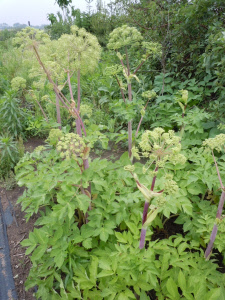Description
Spectacular chartreuse globular umbels of flowers in July
Spectacular chartreuse globular umbels
Spectacular chartreuse globular umbels of flowers in July
Short purple spikes in June-July
Size: 3” x 24”
Care: sun in well-drained soil
Native: Europe & Western Asia
Size: groundcover, rock garden, herb, fragrant foliage, thyme lawn
Thymus from the Greek word for “odor” due to the plant’s fragrance. Ancient Greeks made incense with thyme. This species since at least 1753. Acc’d to Parkinson in 1640 this remedied hysterics in women. Wm. Robinson wrote,”nothing can be more charming than a sunny bank covered with” Thymus serpyllum. LH Bailey extolled it as “prized as an evergreen edging and as cover for rockwork and waste places …The leaves are sometimes used for seasoning.”
OUT OF STOCK
White-lavender flowers in May atop wiry stems look like fantastical birds with too many wings, or a four-cornered bishop’s hat. Ornamental heart-shaped leaves and red stems.
Size: 6-12” x 18” slow spreader
Care: shade to part shade in well-drained to moist well-drained soil. Once roots established, valuable in dry shade
Native: China, Japan & Korea
Its Chinese name is “Yin Yang Ho” meaning “Licentious goat herb, “ because allegedly an aphrodisiac for goats! In China & Japan thought to remedy impotence, liver ailments & all age related maladies. In Western gardens since 1834.
Small purple flowers atop tall leafless stems from July to October. Great see-through blooms for growing in back, middle or front of the garden.
Size: 3-4’ x 8”
Care: full sun in moist, well-drained, fertile soil - self-seeder
Native: South America
Awards: Royal Horticultural Society Award of Merit & Missouri Botanic Garden Plant of Merit.
Introduced to garden cultivation from its native Buenos Aires in 1726 by the Sherard brothers.
Violet racemes all summer through fall
Size: 36” x 12”
Care: Sun, well-drained soil
Native: Southern Europe
Both the Latin and common names are related to flax. Linaria comes from “linum” which is Greek for “flax” and toadflax includes the word “flax.” The leaves of Linaria purpurea resemble flax leaves. According to 17th century English herbalist, John Parkinson, the plant “causes one to make water.” Grown by English plantsman and explorer, Tradescant the Elder, 1634.

